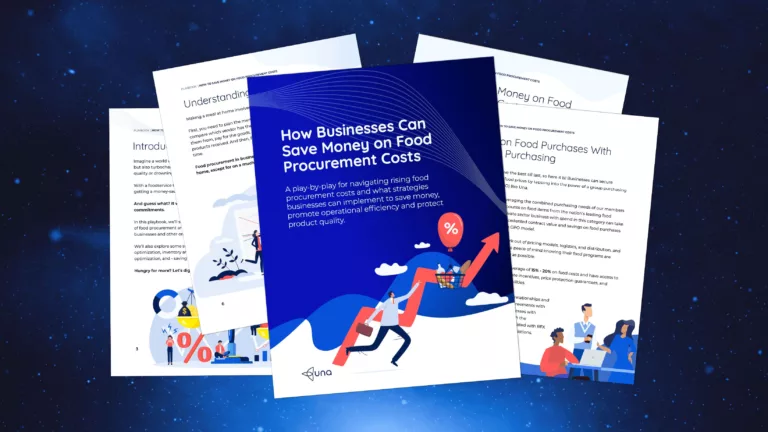
Pain Points in Procurement Series
Benefits Realization in Procurement
Benefits realization in procurement allows professionals to identify areas for improvement, adjust procurement processes, and optimize procurement activities to achieve better outcomes
By Hugo Britt | April 6, 2023
Welcome to Una’s Pain Points in Procurement series. Each week, the Una team will explore one of ten common pain points impacting procurement today, and put forth actionable solutions to each of these challenges.
In your opinion, when exactly does procurement’s role end?
It’s a hotly debated question. Many consider procurement’s job to be complete once a contract has been negotiated and signed. At this point, the temptation is to pat yourself on the back, close the relevant tab on your computer, and move on to the next job.
But ending your involvement at this point ignores a very large elephant in the room: benefits realization.
Benefits realization in procurement
Without monitoring contract compliance and supplier performance over time, the monetary and other benefits you worked so hard to secure throughout the supplier negotiation can be seriously eroded. Months down the track, procurement will have to answer to the head of finance and explain why so little of the promised cost savings materialized on the company’s bottom line.
The below chart from CEBglobal/Diversa shows the danger. Without rigorous contract management, up to 75% of cost savings can disappear within 18 months of signing. This means that the $1 million in savings you’ve promised in the logistics category will end up only being a modest $250k – and your head of finance may have built their budget around the assumption that the full amount will be available.
The good news is that with strong supplier relationship management (SRM), your organization can generate additional supplier value beyond what is in the contract.
Failure to monitor contract compliance and supplier performance over time leads to the erosion of the monetary and other benefits you worked so hard to secure throughout the supplier negotiation process.
What exactly is benefits realization?
Benefits realization is important because it enables organizations to assess the return on investment (ROI) of procurement projects and initiatives.
The benefits of procurement initiatives can be both tangible and intangible, and may include cost savings, improved supplier performance, increased efficiency, enhanced quality, reduced risk, and improved customer satisfaction. Benefits realization involves establishing performance metrics and targets, and tracking progress against these metrics to ensure that the benefits are being realized as planned.
By monitoring benefits realization, procurement professionals can identify areas for improvement, make adjustments to procurement processes, and optimize procurement activities to achieve better outcomes. Ultimately, the goal is to maximize the value delivered by procurement initiatives and ensure they are contributing to the overall success of the organization.
What factors can erode procurement benefits?
There are several factors that can erode benefits realization in procurement including maverick spend, unrealistic expectations, inadequate monitoring, and more.
Maverick spend
The most notorious of all is maverick spend. When individuals or departments within an organization engage in unauthorized or unapproved spending, it can result in a lack of control and oversight over spending, making it difficult to track and monitor procurement activities. This can lead to inconsistencies in spending practices and can result in missed opportunities to realize intended benefits.
Maverick spending can also impact the organization’s ability to achieve its financial goals and objectives by putting a strain on the budget and causing overspending. In addition, it can result in inefficiencies in the procurement process, such as duplicate purchases or paying higher prices for goods and services, which can negatively impact the value delivered by procurement initiatives.
To mitigate the risks associated with maverick spending, procurement professionals need to establish clear spending policies and procedures, as well as implement effective oversight and control mechanisms to prevent unauthorized spending. By doing so, they can help ensure that procurement activities are aligned with the organization’s goals and objectives, and that the intended benefits are realized.
Unrealistic expectations
Inadequate monitoring
If the procurement activities are not monitored effectively, it can be difficult to identify whether the expected benefits are being realized. This can result in missed opportunities to make adjustments to procurement processes to improve outcomes.
Inaccurate data
If the data used to measure the benefits is inaccurate or incomplete, it can result in an inaccurate assessment of the benefits realized and make it difficult to make informed decisions.
Resistance to change
Resistance to change from stakeholders within the organization can erode benefits realization in procurement. This can result in a lack of adoption of new processes or technologies.
Lack of collaboration
Lack of collaboration between procurement and other functions within the organization can erode benefits realization. Procurement needs to work closely with stakeholders across the organization to ensure that the procurement activities are aligned with overall goals and objectives.
To mitigate these risks, procurement needs a clear understanding of the factors that can erode benefits realization and implement effective strategies to address them, including best-practice supplier relationship management.
How a group purchasing organization can help with benefits realization
Did you know that alongside securing massive volume discounts, group purchasing organizations (GPOs) can help your organization improve procurement compliance? From vetting suppliers to inserting non-compliance clauses, building strong supplier relationships, and helping you reduce maverick spend, Una’s services ultimately help ensure the benefits from our pre-negotiated contracts hit your bottom line.
Contact us to learn more.









